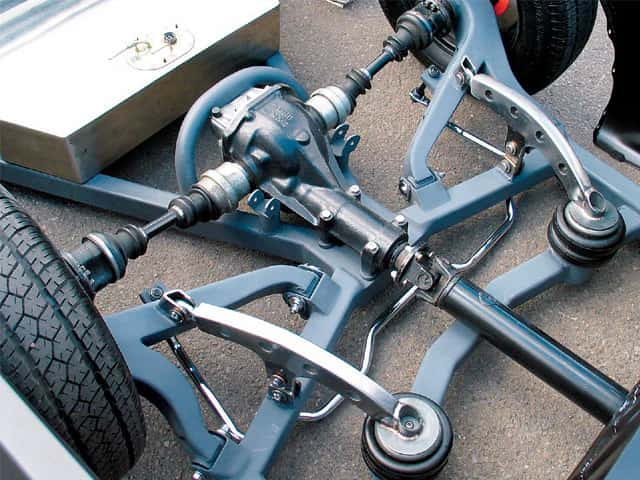Introduction to Suspension Components
Vehicle suspension systems are intricate assemblies that integrate various components to manage and maintain the vehicle’s stability and handling. This section provides an overview of these vital parts and their roles in suspension mechanics.
Understanding Knuckles and Uprights
Composition and Functionality
The upright, also known as the knuckle, is a pivotal component that connects several critical elements like the wheel, brake rotor, hub, brake caliper, and steering arm to the vehicle’s structure. Its design crucially influences the suspension’s geometry, affecting the vehicle’s handling and ride quality.
Independent Suspension Variants
Non-Driven Configuration: In this setup, the upright is linked to the vehicle through upper and lower wishbones, permitting vertical movement and rotation around the kingpin axis.
Driven Configuration: Similar to the non-driven type, but incorporates a half-shaft or driveshaft for power transmission to the wheel, with bearings supporting the shaft within the upright.
The Role of Wishbones and Links
Wishbones and links are essential for connecting the upright to the vehicle’s chassis, influencing the wheel’s movement in various directions. Wishbones, shaped as their name suggests, and links, often in the form of radius rods, regulate the wheel’s lateral, longitudinal, and vertical motion, ensuring stability and responsiveness.
Axles: Types and Functions
Axles play a critical role in connecting the wheels and facilitating their movement. Different axle types include:
- Driven Live Axle: Primarily used in rear-drive vehicles, transferring power from the differential to the wheels;
- Beam Axle: Suitable for both front and rear applications, with variations for steerable and non-steerable configurations;
- Go-Kart Axle: A simple, one-piece shaft without a differential, common in go-karts, where special suspension geometries compensate for the lack of differential action during cornering.
Insights into Suspension Design Strategies
- Maximizing Aerodynamics
Encapsulating moving suspension parts under the bodywork and streamlining exposed components can significantly enhance aerodynamic efficiency, especially in high-speed vehicles.
- Utilizing Scrub Radius for Enhanced Feedback
Scrub radius, the offset between the tire’s centerline and the kingpin axis, plays a pivotal role in transmitting road feedback to the driver. A well-calibrated scrub radius allows drivers to sense traction loss early, facilitating timely corrective actions.
Comparison Table: Traditional vs. Advanced Suspension Systems
| Feature | Traditional Suspension Systems | Advanced Suspension Systems |
|---|---|---|
| Design Focus | Basic stability and handling | Enhanced handling, responsiveness, and aerodynamics |
| Componentry | Standard materials and components | High-strength, lightweight materials and precision parts |
| Aerodynamic Integration | Minimal | High focus on reducing drag and improving downforce |
| Feedback Mechanism | Limited driver-road interaction | Enhanced feedback for improved driver control |
Special Focus: Rally Car Suspension Design
Rally car suspension design is a specialized field, focusing on creating a system capable of handling diverse and rugged terrains at high speeds. Key considerations include:
- Durability: Components must withstand extreme conditions, including jumps, bumps, and varied surfaces;
- Adaptability: The suspension must be adjustable to cater to different terrains, from gravel and mud to asphalt and snow;
- Weight Distribution: Optimizing the weight balance for better handling and control;
- Shock Absorption: Advanced shock absorbers are essential for maintaining stability and tire contact with the ground;
- Ground Clearance: Higher clearance is necessary to navigate rough terrain without damaging the vehicle’s undercarriage;
- Wheel Travel: Extended wheel travel helps in absorbing significant impacts and maintaining traction.
In the competitive world of rally racing, suspension design plays a critical role in a car’s performance. It requires a delicate balance between durability, flexibility, and responsiveness to ensure the vehicle can handle the unpredictable nature of rally courses while providing the driver with the necessary control and feedback.
Conclusion
In summary, the art of suspension design in the automotive world blends mechanical expertise with innovative engineering. Understanding the nuances of components like knuckles, wishbones, and axles, along with applying advanced design strategies like aerodynamic optimization and scrub radius tuning, are key to developing a suspension system that delivers superior performance, handling, and safety. This article serves as a comprehensive guide for enthusiasts and professionals seeking to deepen their understanding of this critical aspect of vehicle engineering.

Leave a Reply